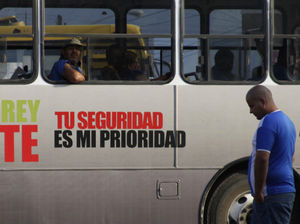By Shannon K. O’Neil
LatIntelligence
Though specific countries usually capture the headlines for their bloodiness — Mexico, Guatemala, Honduras, and often Colombia —security problems are widespread throughout Latin America. For the region which holds the unfortunate distinction of being the world’s most violent, a new Latinobarómetro report looks at the recent trends, and through survey data, tries to tease out how this affects perceptions, people, and, more broadly, democracy.

Some interesting points emerge from this quite extensive study. One is that general perceptions and realities often don’t match up. In part, this is because there are many different types of crime, and governments, media, and other public opinion shapers often only focus on one set of measures.
For instance, Costa Rica, Peru, and Argentina are generally thought of as being some of the more peaceful countries in the hemisphere, due to their relatively low homicide rates (all have below twelve homicides per hundred thousand people). But according to Latinobarómetro’s (self-reported) crime surveys, all three are far above the Latin American average in terms of criminal activity, with Peru ranking second, Costa Rica fourth, and Argentina sixth out of the eighteen surveyed nations.
This means that while the chances of being murdered are less in these countries, the odds of being assaulted are quite high. This helps perhaps explain why Costa Ricans, for example, are more fearful of becoming a victim of a violent crime than are Mexicans, Brazilians, or Hondurans.
These differences may also help to explain the disconnect that so many citizens feel with official rhetoric that places the emphasis solely on murder rates. For instance, the Calderón administration has repeatedly emphasized that Mexico’s murder rates are lower than other big Latin American countries — Venezuela, Colombia, or Brazil. Yet when looking at broader crime surveys, Mexico tops the list.
Over 40 percent say they or a family member have been victims of crime in the last year (compared to the Latin American average of 33 percent). Though the horrific drug violence may indeed still be fairly concentrated, crime is not — a challenge Mexico’s government must acknowledge and face.
Finally, citizens’ faith in Latin American governments’ abilities to tackle insecurity varies. A strong majority — 61 percent — of Latin Americans think their governments can do it — with Uruguayans, Ecuadorians, Brazilians, and Venezuelans most optimistic. The linchpin seems to be the police.
Most Latin Americans don’t trust their police — particularly Guatemalans and Mexicans. But this seems to be the way forward for taking on crime. If these nations can confront the challenges in professionalizing their police forces and gain the confidence of their citizens, then perhaps both the realities and perceptions will shift for the better.
From blogs.cfr.org/oneil. Reprinted with permission. For more analysis and expert blogs, visit CFR.org
Shannon O’Neil the Douglas Dillon fellow for Latin America studies at the Council on Foreign Relations (CFR), and the author of a forthcoming book on Mexico and U.S.-Mexico relations. Dr. O’Neil’s expertise includes political and economic reform in Latin America, with a focus on Mexico and Brazil, U.S.-Latin American relations, energy policy, trade, and immigration. Prior to joining CFR, Dr. O’Neil worked in the private sector as an equity analyst at Indosuez Capital Latin America and Credit Lyonnais Securities. She holds a BA from Yale University, an MA in international relations from Yale University, and a PhD in government from Harvard University. Readers can follow her on Twitter at @latintelligence.


